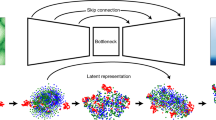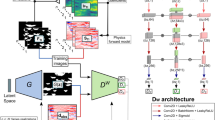Abstract
Reconstruction of field quantities from sparse measurements is a problem arising in a broad spectrum of applications. This task is particularly challenging when the mapping between sparse measurements and field quantities is performed in an unsupervised manner. Further complexity is added for moving sensors and/or random on–off status. Under such conditions, the most straightforward solution is to interpolate the scattered data onto a regular grid. However, the spatial resolution achieved with this approach is ultimately limited by the mean spacing between the sparse measurements. In this work, we propose a super-resolution generative adversarial network framework to estimate field quantities from random sparse sensors. The algorithm exploits random sampling to provide incomplete views of the high-resolution underlying distributions. It is hereby referred to as the randomly seeded super-resolution generative adversarial network (RaSeedGAN). The proposed technique is tested on synthetic databases of fluid flow simulations, ocean surface temperature distribution measurements and particle-image velocimetry data of a zero-pressure-gradient turbulent boundary layer. The results show excellent performance even in cases with high sparsity or noise level. This generative adversarial network algorithm provides full-field high-resolution estimation from randomly seeded fields with no need of full-field high-resolution representations for training.
This is a preview of subscription content, access via your institution
Access options
Access Nature and 54 other Nature Portfolio journals
Get Nature+, our best-value online-access subscription
$29.99 / 30 days
cancel any time
Subscribe to this journal
Receive 12 digital issues and online access to articles
$119.00 per year
only $9.92 per issue
Buy this article
- Purchase on Springer Link
- Instant access to full article PDF
Prices may be subject to local taxes which are calculated during checkout





Similar content being viewed by others
Data availability
All datasets used in this work are openly available in Zenodo, accessible at https://doi.org/10.5281/zenodo.7191210
Code availability
All codes developed in this work are openly available in GitHub, accessible through the link https://github.com/eaplab/RaSeedGAN
References
Bolton, T. & Zanna, L. Applications of deep learning to ocean data inference and subgrid parameterization. J. Adv. Model. Earth Syst. 11, 376–399 (2019).
Akiyama, K. et al. First M87 event horizon telescope results. III. Data processing and calibration. Astrophys. J. Lett. 875, L3 (2019).
Yakhot, A., Anor, T. & Karniadakis, G. E. A reconstruction method for gappy and noisy arterial flow data. IEEE Trans. Med. Imaging 26, 1681–1697 (2007).
Manohar, K., Brunton, B. W., Kutz, J. N. & Brunton, S. L. Data-driven sparse sensor placement for reconstruction: demonstrating the benefits of exploiting known patterns. IEEE Control Syst. Mag. 38, 63 (2018).
Cortina-Fernández, J., Sanmiguel Vila, C., Ianiro, A. & Discetti, S. From sparse data to high-resolution fields: ensemble particle modes as a basis for high-resolution flow characterization. Exp. Therm. Fluid Sci. 120, 110178 (2020).
Fukami, K., Maulik, R., Ramachandra, N., Fukagata, K. & Taira, K. Global field reconstruction from sparse sensors with Voronoi tessellation-assisted deep learning. Nat. Mach. Intell. 3, 945 (2021).
Gundersen, K., Oleynik, A., Blaser, N. & Alendal, G. Semi-conditional variational auto-encoder for flow reconstruction and uncertainty quantification from limited observations. Phys. Fluids 33, 017119 (2021).
Shen, H. et al. Missing information reconstruction of remote sensing data: a technical review. IEEE Geosci. Remote Sens. Mag. 3, 61 (2015).
Callaham, J. L., Maeda, K. & Brunton, S. L. Robust flow reconstruction from limited measurements via sparse representation. Phys. Rev. Fluids 4, 103907 (2019).
Berkooz, G., Holmes, P. & Lumley, J. L. The proper orthogonal decomposition in the analysis of turbulent flows. Annu. Rev. Fluid Mech. 25, 539 (1993).
Schmid, P. J. Dynamic mode decomposition of numerical and experimental data. J. Fluid Mech. 656, 5 (2010).
Everson, R. & Sirovich, L. Karhunen-Loève procedure for gappy data. J. Opt. Soc. Am. A 12, 1657 (1995).
Venturi, D. & Karniadakis, G. E. Gappy data and reconstruction procedures for flow past a cylinder. J. Fluid Mech. 519, 315 (2004).
Raben, S. G., Charonko, J. J. & Vlachos, P. P. Adaptive gappy proper orthogonal decomposition for particle image velocimetry data reconstruction. Meas. Sci. Technol. 23, 025303 (2012).
Huang, X. Compressive sensing and reconstruction in measurements with an aerospace application. AIAA J. 51, 1011 (2013).
Maulik, R., Fukami, K., Ramachandra, N., Fukagata, K. & Taira, K. Probabilistic neural networks for fluid flow surrogate modeling and data recovery. Phys. Rev. Fluids 5, 104401 (2020).
Gao, H., Sun, L. & Wang, J.-X. Super-resolution and denoising of fluid flow using physics-informed convolutional neural networks without high-resolution labels. Phys. Fluids 33, 073603 (2021).
Erichson, N. B. et al. Shallow neural networks for fluid flow reconstruction with limited sensors. Proc. R. Soc. A: Math. Phys. Eng. Sci. 476, 20200097 (2020).
Sun, L. & Wang, J.-X. Physics-constrained bayesian neural network for fluid flow reconstruction with sparse and noisy data. Theor. Appl. Mech. Lett. 10, 161 (2020).
Arzani, A., Wang, J.-X. & D’Souza, R. M. Uncovering near-wall blood flow from sparse data with physics-informed neural networks. Phys. Fluids 33, 071905 (2021).
Brunton, S. L., Noack, B. R. & Koumoutsakos, P. Machine learning for fluid mechanics. Annu. Rev. Fluid Mech. 52, 477 (2020).
Fukami, K., Fukagata, K. & Taira, K. Super-resolution reconstruction of turbulent flows with machine learning. J. Fluid Mech. 870, 106 (2019).
Kim, H., Kim, J., Won, S. & Lee, C. Unsupervised deep learning for super-resolution reconstruction of turbulence. J. Fluid Mech. 910, A29 (2021).
Güemes, A. et al. From coarse wall measurements to turbulent velocity fields through deep learning. Phys. Fluids 33, 075121 (2021).
Deng, Z., He, C., Liu, Y. & Kim, K. C. Super-resolution reconstruction of turbulent velocity fields using a generative adversarial network-based artificial intelligence framework. Phys. Fluids 31, 125111 (2019).
Stengel, K., Glaws, A., Hettinger, D. & King, R. N. Adversarial super-resolution of climatological wind and solar data. Proc. Natl Acad. Sci. USA 117, 16805 (2020).
Ledig, C. et al. Photo-realistic single image super-resolution using a generative adversarial network. In Proc. IEEE CVPR 4681–4690 (IEEE, 2017).
Deng, N., Noack, B. R., Morzyński, M. & Pastur, L. R. Low-order model for successive bifurcations of the fluidic pinball. J. Fluid Mech. 884, A37 (2020).
Scarano, F. Iterative image deformation methods in PIV. Meas. Sci. Technol. 13, R1 (2001).
Radford, A., Metz, L. & Chintala, S. Unsupervised representation learning with deep convolutional generative adversarial networks. Preprint at https://arxiv.org/abs/1511.06434 (2015).
Sønderby, C. K., Caballero, J., Theis, L., Shi, W. & Huszár, F. Amortised map inference for image super-resolution. Preprint at https://arxiv.org/abs/1610.04490 (2016).
Lozano-Durán, A., Flores, O. & Jiménez, J. The three-dimensional structure of momentum transfer in turbulent channels. J. Fluid Mech. 694, 100 (2012).
Schlatter, P. & Örlü, R. Assessment of direct numerical simulation data of turbulent boundary layers. J. Fluid Mech. 659, 116 (2010).
Atkinson, C., Buchmann, N. A., Amili, O. & Soria, J. On the appropriate filtering of PIV measurements of turbulent shear flows. Exp. Fluids 55, 1 (2014).
Wang, X. et al. ESRGAN: Enhanced Super-Resolution Generative Adversarial Networks. In Proc. ECCV Workshop (2018) (eds Leal-Taixé, L. & Roth, S.) 63–79 (Springer, 2018).
Gross, S. & Wilber, M. Training and investigating residual nets. Facebook AI Res. 6, 3 (2016).
Shi, W. et al. Real-time single image and video super-resolution using an efficient sub-pixel convolutional neural network. In Proc. IEEE CVPR 1874–1883 (IEEE, 2016).
Abadi, M. et al. TensorFlow: a system for large-scale machine learning. In 12th USENIX Symposium on Operating Systems Design and Implementation (OSDI 16) 265–283 (2016).
Li, Y. et al. A public turbulence database cluster and applications to study Lagrangian evolution of velocity increments in turbulence. J. Turbul. 9, N31 (2008).
Acknowledgements
This project has received funding from the European Research Council (ERC) under the European Union’s Horizon 2020 research and innovation programme (grant agreement No. 949085) received by S.D. NOAA High Resolution SST data provided by the NOAA/OAR/ESRL PSL.
Author information
Authors and Affiliations
Contributions
A.G.: methodology, software, validation, investigation, data curation, writing—original draft, writing—review and editing, visualization. C.S.V.: conceptualization, methodology, writing—original draft, writing—review and editing. S.D.: methodology, software, resources, data curation, supervision, writing—original draft, writing—review and editing, funding acquisition.
Corresponding authors
Ethics declarations
Competing interests
The authors declare no competing interests.
Peer review
Peer review information
Nature Machine Intelligence thanks the anonymous reviewers for their contribution to the peer review of this work.
Additional information
Publisher’s note Springer Nature remains neutral with regard to jurisdictional claims in published maps and institutional affiliations.
Extended data
Extended Data Fig. 1 Pixel-based root mean square error evaluated in the test data set as a function of the number of training samples for Test Case 1 (left) and Test Case 2 (right) with fu = 4.
The error is scaled with the standard deviation of the corresponding fluctuating quantities. Green and yellow lines indicate respectively the error on the streamwise and crosswise velocity components.
Rights and permissions
Springer Nature or its licensor (e.g. a society or other partner) holds exclusive rights to this article under a publishing agreement with the author(s) or other rightsholder(s); author self-archiving of the accepted manuscript version of this article is solely governed by the terms of such publishing agreement and applicable law.
About this article
Cite this article
Güemes, A., Sanmiguel Vila, C. & Discetti, S. Super-resolution generative adversarial networks of randomly-seeded fields. Nat Mach Intell 4, 1165–1173 (2022). https://doi.org/10.1038/s42256-022-00572-7
Received:
Accepted:
Published:
Issue Date:
DOI: https://doi.org/10.1038/s42256-022-00572-7
This article is cited by
-
SpiDe-Sr: blind super-resolution network for precise cell segmentation and clustering in spatial proteomics imaging
Nature Communications (2024)
-
WindSeer: real-time volumetric wind prediction over complex terrain aboard a small uncrewed aerial vehicle
Nature Communications (2024)
-
The fluidic pinball with symmetric forcing displays steady, periodic, quasi-periodic, and chaotic dynamics
Theoretical and Computational Fluid Dynamics (2024)
-
Development of the Senseiver for efficient field reconstruction from sparse observations
Nature Machine Intelligence (2023)
-
Identifying dominant flow features from very-sparse Lagrangian data: a multiscale recurrence network-based approach
Experiments in Fluids (2023)



